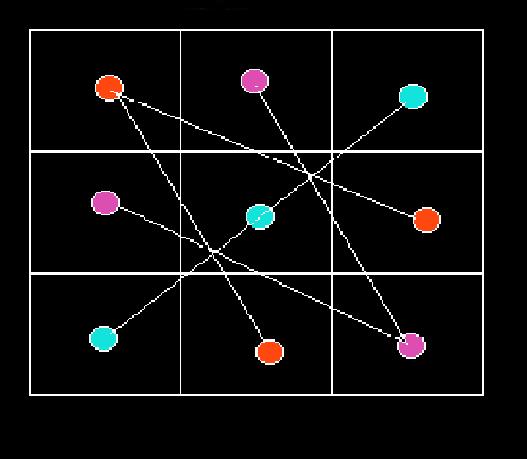

The tables of partial imaginary tuples listed in Part IB, Part IC,
Part IIIC, Part ID and Part IE
are useful, when squared, as right diagonals for magic square of squares.
I will show that the averages of each of two tuple numbers from the designated tables may be used to generate the next number of averages
in the geometric progressions via successive multiplications with the common ratio R
=
Thus, for example we can generate the geometric progression:
where xavg is a placeholder for aavg, bavg, or cavg. I will show that starting with the initial xavg and gradually replacing the starting xavg with the next real value, there comes a point where the numbers take on the real values. From the tables below, using seven columns and ten rows, the seventh column appears to be that point. Increasing the number of rows, however, produces numbers which are initially far from the real values. To get these numbers more in line with the real values requires us to increase the number of columns as far as is required.
Three tables are generated one for aavg (Table GP1),
one bavg (Table GP2) and one for
cavg (Table GP3).
The sequences for these table were obtained from
where the last underlined number was obtained by multiplying 542868888 by R and not from a table. The numbers are arranged in columns and the initial number averages are multiplied by R over and over until the end of the column. Going across the rows we can see that the numbers approach the real number averages as the numbers get bigger and bigger.
| aavgi | 72i | 408i | 2376i | 13848i | 80712i | 470424i | 2741832i |
|---|---|---|---|---|---|---|---|
| aiavg × R | 419.6i | 2378i | 13848.3i | 80712i | 470424i | 2741832i | 15980568i |
| aiavg × R2 | 2445.9i | 13860i | 80714i | 470424.4i | 2741832i | 15980568i | 93141576i |
| aiavg × R3 | 14255.6i | 80782i | 470436i | 2741834i | 15980568.4i | 93141576i | 542868888i |
| aiavg × R4 | 83088i | 470831.6i | 2741902i | 15980580i | 93141578i | 542868888.3i | 3164071752i |
| aiavg × R5 | 484272i | 2744208i | 15980975.7i | 93141646i | 542868900i | 3164071754i | |
| aiavg × R6 | 2822544i | 15994416i | 93143952i | 542869295.6i | 3164071822i | ||
| aiavg × R7 | 16450992i | 93222288i | 542882736i | 3164074128i | |||
| aiavg × R8 | 95883408i | 543339312i | 3164152464i | ||||
| aiavg × R9 | 558849456i | 3166813584i | |||||
| aiavg × R10 | 3257213328i | ||||||
The sequence for bavg of tuple (aavgi,bavg, cavg) is as follows:
where the last underlined number was obtained by multiplying 111960996 by R and not from a table, just as was done above.
| bavg | 14 | 84 | 490 | 2856 | 16646 | 97020 | 565474 |
|---|---|---|---|---|---|---|---|
| bavg × R | 81.6 | 489.6 | 2856 | 16646 | 97020 | 565474 | 3295824 |
| bavg × R2 | 475.6 | 2853.5 | 16645.6 | 97020 | 565474 | 3295824 | 19209470 |
| bavg × R3 | 2772 | 16631.6 | 97017.5 | 565473.6 | 3295824 | 19209470 | 111960996 |
| bavg × R4 | 16156 | 96936 | 565459.5 | 3295821.5 | 19209469.6 | 111960996 | 652556506 |
| bavg × R5 | 94164 | 564984 | 3295740 | 19209455.6 | 111960993.5 | 652556505.6 | |
| bavg × R6 | 548828 | 3292968 | 19208980 | 111960912 | 652556491.6 | ||
| bavg × R7 | 3198804 | 19192824 | 111958140 | 652556016 | |||
| bavg × R8 | 18643996 | 111863976 | 652539860 | ||||
| bavg × R9 | 108665172 | 651991032 | |||||
| bavg × R10 | 633347036 | ||||||
| cavg | 75 | 425 | 2475 | 14425 | 84075 | 490025 | 2856075 |
|---|---|---|---|---|---|---|---|
| cavg × R | 437.1 | 2477.1 | 14425.4 | 84075.1 | 499025 | 2856075 | 16646425 |
| cavg × R2 | 2547.8 | 14437.5 | 84077.1 | 490025.4 | 2856075 | 16646425 | 97022475 |
| cavg × R3 | 14849.6 | 84147.9 | 490037.5 | 2856077.1 | 16646425.4 | 97022475 | 565488425 |
| cavg × R4 | 86550 | 490449.6 | 2856147.9 | 16646437.5 | 97022477.1 | 565488425.4 | 3295908077 |
| cavg × R5 | 504450 | 2858550 | 16646849.6 | 97022547.9 | 565488437.5 | 3295908077 | |
| cavg × R6 | 2940150 | 16660850 | 97024950 | 565488849.6 | 3295908148 | ||
| cavg × R7 | 17136450 | 97106550 | 565502850 | 3295910550 | |||
| cavg × R8 | 99878550 | 565978450 | 3295992150 | ||||
| cavg × R9 | 582134850 | 3298764150 | |||||
| cavg × R10 | 3392930550 | ||||||